
Travel Guide
Introduction
As a temple related to both the Ashikaga family and Emperor Go-Daigo, Tenryuji Temple is among the most important Zen temples in Kyoto. The temple is held in high esteem, and is ranked as the head temple of its own school within the Rinzai Zen sect of Japanese Buddhism. It was ranked first among Kyoto Gozan (five great Zen temples in Kyoto) during the Muromachi period. It was established in 1339 by Shogun Ashikaga Takauji on the site of the Kameyama Detached Palace, for the purpose of consoling the spirit of Emperor Go-Daigo. It is a World Heritage Site and one of the most historic sites in Kyoto.
The main attraction of Tenryuji Temple is the Zen garden dating back to the 14th century. Unlike the temple buildings which have been destroyed over the centuries, Tenryuji Temple's garden survived the centuries in its original form. Current buildings were rebuilt after the Meiji era. Created by the famous garden designer Muso Soseki, who also designed the gardens of Kokedera and other important temples, the beautiful landscape garden features a central pond surrounded by rocks, pine trees and the forested Arashiyama mountains. The pond catches the reflection of the maple trees and large rough-cut rocks on the periphery. It also makes use of "borrowed scenery" from the nearby hills of Arashiyama, which appear to be the next tier of the garden. Many elements of this garden were prototypes for later gardens built elsewhere. Muso Soseki also served as Tenryuji Temple's first head priest.
In autumn, the maples provide a fine display of fall color, while in spring you might see the blossoms of wild cherry trees or the stunted trunks of Japanese red pines on the distant hills. In any season, as you sit in the shelter and view the garden, you will likely find your thoughts settling and your body relaxing. The garden has a way of calming one's spirit and it was designed partly for this reason.
The name Tenryuji Temple means, "Heavenly Dragon Temple," and it was built after a shogun who dreamed of a dragon rising from a nearby river, which was taken to mean that the recently-deceased Emperor Go-Daigo was not resting peacefully. The temple with its garden was built to placate his spirit. It is now the headquarters of the Rinzai School of Zen Buddhism. Visitors can also sample the temple's Zen vegetarian cuisine, known as "shojin ryori."
History
Empress Tachibana-no-Kachiko (786-850), the consort of Emperor Saga (786-842), founded a big convent called Danrinji Temple some time in Jowa era (834-848) in this place. In the middle of Heian period (794-1192) the convent fell into ruin. Retired emperor Go-Saga (1220-1272) built a detached palace called Kameyama-dono on the deserted convent site. Kameyama-dono was inherited by Emperor Kameyama (1249-1305) and his grandson Emperor Go-Daigo (1288-1339).
In the year 1339, Priest Muso Soseki made a proposal to the first Muromachi Shogun, Ashikaga Takauji (1305-1358) and his brother Tadayoshi (1306-1352) about establishing a temple for the late emperor Go-Daigo, who had initially coordinated with the samurai brothers to overthrow the Kamakura Shogunate and then changed to be the deadly enemy of them. They agreed with the priest but the newly-established Shogunate government did not have enough money so that they had to start trade with China to make funds for building the temple.
In the year 1345, the Zen temple was officially founded with Muso Soseki being the first head priest. The buildings of the temple suffered fires several times during its history. The present O-Hojo building was rebuilt in 1899 followed by other buildings.
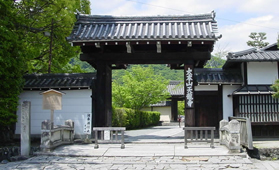 |
Somon Somon is the entrance gate of Tenryuji Temple. There is a wide area of maple trees at the south of the approach to the temple, making the temple the famous viewing spot of autumn colors in Kyoto. |
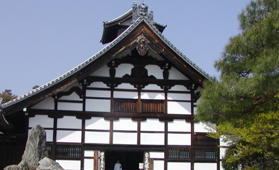 |
Kuri A kuri is the kitchen of a Zen monastery, typically located behind the butsuden (or, Buddha Hall). 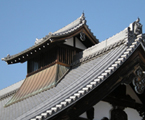 Historically the kuri functions as the kitchen and administrative office but later became the residence for abbot and his familiy. Because it was a kitchen, there is a chimney on the roof (as shown in the right image). Historically the kuri functions as the kitchen and administrative office but later became the residence for abbot and his familiy. Because it was a kitchen, there is a chimney on the roof (as shown in the right image). |
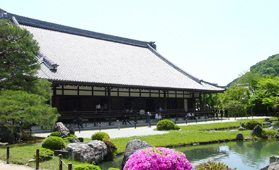 |
Dai Hojo Dai Hojo was built in the Meiji era, surrounded by kairo (covered colonnade). Visitors can enjoy Sogen-chi Garden from the corridor. Dai Hojo houses a Buddha statue Shyaka Nyorai. The buildings of Tenryuji Temple were burn down for 8 times but the statue remains safely. |
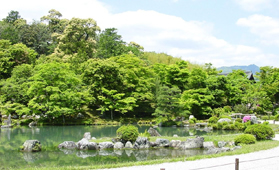 |
Sogen-chi Garden The garden is designed to enable a visitor to enjoy changes in scenery while walking around the Sogen-chi Pond. The scenery of two hills - Kameyama and Arashiyama - both of which are located outside the garden, form part of the composition. This technique of making use of the surrounding landscape in garden design is known as shakkei. Stonework on a hill at the back of the pond symbolizes a mountain stream cascading into the pond. There are also stones symbolizing carp. This idea stems from a traditional Chinese fable in which a carp swims up a waterfall to become the more superior dragon. Among the gardens designed by master gardener Muso Kokushi, this garden is believed to be the least changed and is considered one of the most exquisite of all Japanese gardens. |
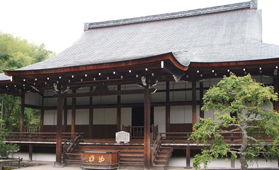 |
Tahoden Tahoden was the site of first exercise hall Dairinji Temple and the imperial villa of Emperor Kameyama. The current building was rebuilt in 1934. Emperor Go-Daigo learned and raised here and since this was the sacred temple of Emperor Go-Daigo, the temple houses many statues of the Emperor. There is a big weeping cherry tree in front of the temple. |
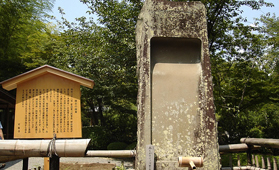 |
Inkstone The painter Shonen Suzuki painted a dragon which is said to guard the Buddhist on the celling of Hatto in 1899. While paining with the brush and ink, over 60 monks help on making ink. The inkstone was built to commemorate the painter. It is said that people who make pray to the inkstone will improve the shodo (calligraphy) skill. |
Travel Advice
Sightseeing
- Kyoto Gozan includes Tenryuji Temple, Shokokuji Temple, Kenninji Temple, Tofukuji Temple and Manjuji Temple. The head temple presiding over the Gozan in Kyoto is Nanzenji Temple.
- It is said that people who drink the water from Ai-no-izumi (the love spring) will receive Love and Luck.
- There is a building called Tosu at the south of Sogen-chi Garden. Lavatory in a Zen temple is called Tosu.
- The guide dog is allowed to enter the courtyard only.
Autumn Leaves
Tenryuji Temple is a spot to see autumn leaves. Please see Autum Leaves in Tenryuji Temple.
Visit
| Address | 68 Susukinobaba-cho, Tenryuji, Saga, Ukyo-ku, Kyoto-shi, Kyoto | |
| Phone | 075-881-1235 | |
| Admission | Adult: 500 yen Student: 300 yen |
Adult: over 15 Student: 6 to 14 Tickets required for facilities |
| Hours | 08:30 to 17:30 | |
| Closed | Open 7 Days a Week | |
| Duration | 30 minutes | |
| Getting There | By Train 1 minute walk from Arashiyama Station on Keifuku Electric Railroad Arashiyama Honsen. 13 minute walk from Saga Arashiyama Station on JR Sagano Line. 15 minute walk from Arashiyama Station on Hankyu Railway Kyoto Line. Take City Bus No.11, 28 or 93 to the Arashiyama Tenryuji-mae bus stop, then walk approximately 1 minute. Take City Bus No.61, 72 or 83 to the Keifuku Arashiyamaeki-mae bus stop, then walk approximately 1 minute. By Car Take Meishin Expressway to Kyoto-higashi exit and take National Highway route 1, Kujo-dori, Nishi'oji-dori and Shijo-dori. It is approximately 40 minutes from exit. |
|
| Parking | Paid parking available | |

